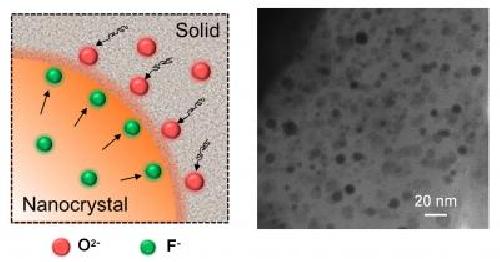WASHINGTON - If you've ever experienced a bad sunburn, you know the damage that ultraviolet (UV) light can cause to living cells (like your skin). Out in space, where the level of radiation from the sun can be even higher, it can damage sensitive electronics aboard in-flight spacecraft.
The dangers of UV light have prompted scientists to search for versatile materials that block UV and can withstand long radiation exposure times without falling apart. Now a group of researchers in China has developed a new method to create transparent, glass-based materials with UV-absorbing power and long lifetimes. The team demonstrated that the new glass effectively protects living cells and organic dyes, and believe it could also be developed as a transparent shield to protect electronics in space. They describe their results in Optical Materials Express, a journal of The Optical Society.
The researchers used a metal oxide --cerium (IV) oxide (CeO2)-- well-known for its ability to absorb UV photons to craft the composite glass-based UV absorber.
 These images show UV-induced morphological changes of multinucleated giant cells, unprotected and protected by the group's UV absorber. Credit: Shifeng Zhou/ South China University of Technology
These images show UV-induced morphological changes of multinucleated giant cells, unprotected and protected by the group's UV absorber. Credit: Shifeng Zhou/ South China University of Technology
Other key features of the final composite material are the optical transparency of the glass and the material's ability to suppress the separation of photo-generated electrons and holes. The later feature slows down a light-induced reaction that would lead to the ultimate breakdown of the material under prolonged exposure to UV radiation.
The method the team developed is based on the self-limited nanocrystallization of glass.
"Self-limited nanocrystallization of glass can be achieved by taking advantage of the rigid environment of the solid-state matrix, rather than the conventional solution and vapor conditions to modulate the ionic migration kinetics," explained Shifeng Zhou, School of Materials Science and Engineering, South China University of Technology, Guangzhou, China. "It allows us to create glass-ceramics embedded with a CeO2:fluorine (F) nanostructure."
The viscous glass matrix involved poses a considerable constraint for oxide (O2-) and F- ion diffusion, so the group gradually etches trifluorocerium (CeF3) by O2- ions within an oxide matrix until F--doped CeO2 is generated in a controllable manner. It's important to note that this technology is also routinely used to prepare other UV absorbers such as zinc oxide (ZnO) and titanium oxide (TiO2).
"This work establishes an effective approach for the functionalization of glass," said Zhou. "And it allowed us to demonstrate the construction of a novel glass-based UV absorber."
The group's innovative approach for fabricating the UV absorber has important implications "for the construction of novel glass materials with new functions via microstructure engineering," he added.
Among the group's key discoveries was finding that the self-limited nanocrystallinization of glass is indeed an effective way to functionalize it. The special glass they created suppresses photocatalytic and catalytic activity, while boasting an extremely high UV-absorbing capacity.
"Our glass shows excellent optical quality, and it can be easily fabricated either in bulk form or as a film," said Zhou. "It effectively protects organic dye and living cells from UV radiation damage."
Potential applications for the group's work include radiation hardening of electronic devices, serving as a biological shield, and preserving cultural artifacts and relics.
"In space, the high-energy radiation environment encountered by electronic equipment aboard spacecraft can be quite damaging," noted Zhou. "Fortunately, in the future, if you add a radiation-blocking coating onto the surface of the package - a transparent glass/polymer material - the device would be well protected, and its service lifetime may be prolonged."
In terms of applications as biological shields and to preserve cultural artifacts and relics, the special glass can "protect cells from UV-induced damage," he added.
Going forward, the group plans to focus their efforts on developing other novel and effective glass-based UV absorbers, using the self-limited nanocrystallization method.
"We'll explore ways for large-scale fabrication of this type of film, which is extremely important for practical applications," said Zhou. "Our group will also further study the functionalization of glass based on its microstructure engineering, because we believe this fundamental research may have great significance for the glass industry."
source: The Optical Society